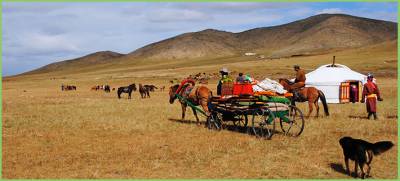9:41 AM Mongolian Nomadic life | |
|
For 3 000 years, the populace of the steppes have embraced a peaceful lifestyle moving in the hunt of best fields and camping areas. They live by and for their animals, in the front line of which the stallion without a doubt was the first creature trained in these unbounded knolls. Today, more or less a large portion of ofMongolia's populace is as yet meandering the limitless fields living in the ger and moving their campings a few times each year on the grounds with no wall. Traveling life flourishes in summer and makes due in winter. Considering climatic conditions, particularly amid winter, such way of life may appear to the outside world to be a hard method for living. In any case, Mongolians have produced for a considerable length of time such qualities as quality and versatility that are vital for survival in this cruel nature, which is their valued country. The quantity of migrants has altogether diminished throughout the most recent years. Wanderers move to the capital city being forced by the need to hunt down method for subsistence or pulled in by city lights and saw preferences of urban life. After the last awful winters numerous roaming families lost every one of their groups that were the wellspring of living. Such circumstance obliging a crisis help brought about huge provincial to-urban relocation, particularly from the west of the nation, driving roaming herders and in addition stockbreeders from little rustic towns towards suburbia of the capital city. Customarily, Mongolian wanderers raise 5 types of animals known as the 5 gags: steeds, cows or yaks, sheep, goats and camels. Reindeers are raised by the Tsaatan individuals who live in the northwest regions around the lake Khovsgol bordering the Russian Siberia. Mongolia is the place that is known for the steed. Any migrant can ride and additionally he or she can walk or run. Little Mongolian stallions are inconceivably safe. They experience all year around in semi-wild groups, assembled just for the draft and the catch. They are part of the way observed over by herders to guard just against the scalawags. Aside from being utilized for riding and legacy, the stallion gives the migrants their favored beverage -airag, which is aged and marginally alcoholized horse's milk. Mongolians of any ages drink liters of airag in summer lauding its temperances for wellbeing and the digestive tract ! Airag of specific ranges is more popular when contrasted with others. The taste relies on upon the touching grounds and the skillfulness of the producer. On the off chance that it is applicable to make a correlation, one can say that airag has more or less the same social and social significance as wine can have in France. Stallions are unquestionably on the high when they are included for the yearly race of Naadam. Ridden by youthful racers, they exhibit their entire being and excellence for the pride of their proprietor and reproducer and the brilliance goes to the stallion and the proprietor than to the specific rider. Yaks and dairy animals bring meat, cowhide and milk, which is utilized for making a mixed bag of journal items, for example, yogurt, cheddar and aaruul (or dried cheddar) that constitute the fundamental eating routine of wanderers amid the mid year months. Aaruul, which speaks to cheddar chunks of diverse shapes and sizes dried on the top of the ger, is particularly famous and is devoured throughout the entire year. Sheep is the most widespread creature utilized for meat and milk, the essential sustenance of migrant way of life, skins and fleece for dress and felt for ger covering. Goats are more hard to raise than sheep, yet they are acknowledged for their meat and especiallycashmere, goat's down, one of the profoundly esteemed regular strands. Mongolia is one of the biggest makers and exporters of the finest quality cashmere on the planet. Two-bumped Bactrian camels are utilized as a part of Gobi for meat, milk, fleece and for riding and as a transporter for long separation developments. Traveling families frequently accumulated in gatherings move by and large in the span of 50 to 100 kilometers, in any event twice per year, in spring (May) and toward the start of winter (October). In any case, more noteworthy relocations are here and there vital in the hunt of better fields. Uvuljuu or winter camps are situated in territories that are normally protected from wind and are outfitted with stables for the creatures to stay for the night. Travelers dedicate the majority of the day to giving a second thought after their creatures – observing over, draining, shearing, or brushing – to create felt and felt garments, cheddar and other dairy items. Steeds are raised and took care of by men however are drained by ladies. Wanderers utilize a shaft rope or uurga to accumulate the crowds and to catch the stalli | |
|
| |
| Total comments: 0 | |


